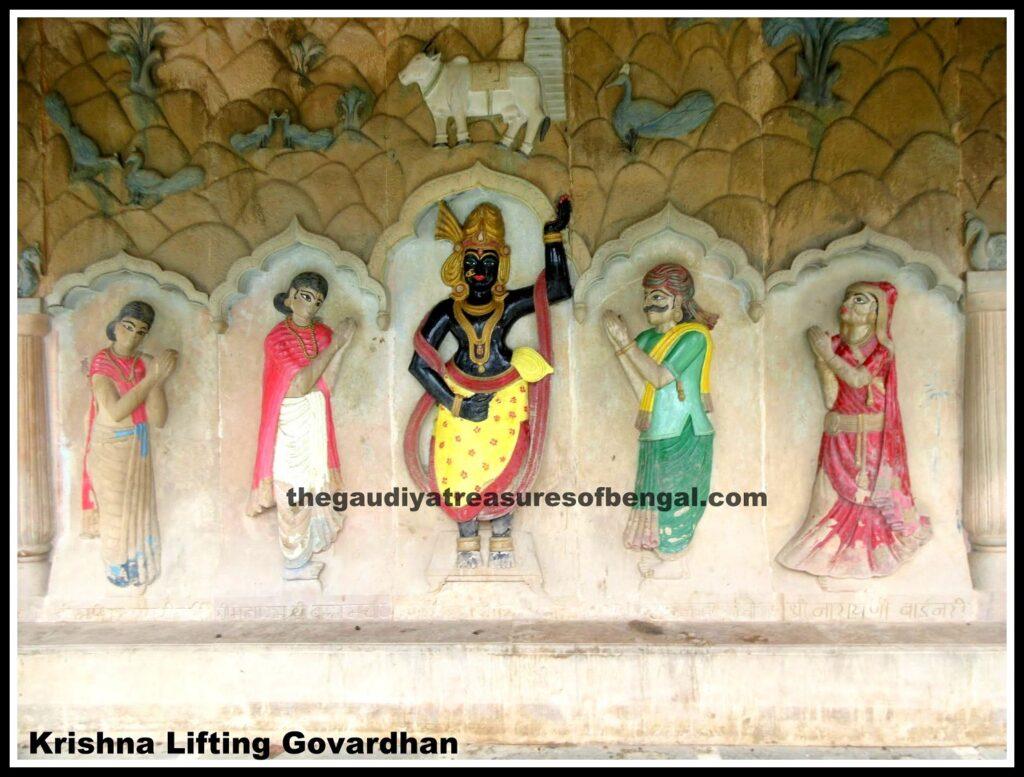
Embarking on the sacred Govardhan Parikrama is a profoundly auspicious act, as it serves as a reverential offering to Radha and Krishna. The Govardhan Parikrama encompasses an approximate distance of 23 kilometers. In the sacred scripture, Srimad Bhagavatam, it is recounted how Lord Krishna instructed the Vrajavasis to worship the resplendent Govardhan Hill. Among the essential aspects of this worship was the practice of circumambulating the majestic hill by the gopas and gopis, an act that immensely delighted Lord Sri Krishna. Indeed, the path to true perfection lies in treading the footsteps of illustrious souls. Sri Chaitanya Mahaprabhu, during His visit to Vrindavan, personally embarked on the Govardhan Parikrama. With an exalted vision, He perceived each and every stone of Govardhan Hill as inseparable from the divine form of Lord Krishna. Even Madhavendra Puri, a revered saint, performed this sacred circumambulation. Great devotees such as Ishwara Puri, Nityananda Prabhu, and Adwaita Acharya expressed their deep devotion by encircling Sri Govardhan with utmost reverence. The six Goswamis, luminous figures in the devotional tradition, considered the Govardhan Parikrama an integral part of their spiritual practices. Raghunath Das Goswami resided near Radha Kunda, situated at the foothills of Govardhan. Even in his advanced years, Sanatana Goswami diligently performed the Govardhan Parikrama daily while residing at Manasi Ganga near the Chakleshwar Mahadev temple. Similarly, other eminent Vaishnavas like Narottama Das Thakur and Srinivas Acharya undertook the sacred Govardhan Parikrama. Vishwanath Chakravarty Thakur found solace near the vicinity of Govardhan Hill, and revered personalities such as Srila Bhakti Siddhanta Sarasvati and Bhaktivinoda Thakur also had their abodes in close proximity to Govardhan. Bhaktivedanta Swami Prabhupada, Founder acharya of Iskcon, expressed his final desire to be taken on a Parikrama of Govardhan, thus emphasizing the immense sanctity and importance of this worship. The dust beneath our feet as we walk upon Govardhan Hill is not merely the sanctified soil of Vraja Mandala; it is also adorned with the sacred particles from the lotus feet of these divine personalities. It is said that in Vrindavan, there exist three profoundly purifying elements for the heart – the dust of Vraja, the sacred Yamuna, and the majestic Govardhan. This article delves into the hallowed destinations encountered during the sacred Govardhan Parikrama.
Oh Govardhana, majestic monarch of mountains, your divine name, like nectar, gracefully emanates from the lotus-like lips of Sri Radha, the most cherished servant of Lord Hari. The Vedas proclaim you as the revered tilaka adorning the sacred land of Vraja. I beseech you, grant me the privilege of dwelling in your blessed vicinity – Stavavali, Raghunath das Goswami
Radha Kunda and Shyam Kunda
Radha Kunda, the divine well, holds the esteemed reputation of being the sacred bathing spot of the revered Radharani. It is said that in a moment of righteous anger, Radharani chastised Krishna for tainting himself by slaying a bull (demon Arishtasura), a symbol of dharma (righteousness). She suggested that he could cleanse his impurities by taking a dip in every holy river. Rather than traversing to each sanctified watercourse, Krishna simply struck the ground with his heel, causing water from every sacred river to gush forth. This consecrated site came to be known as Shyama-Kunda. In a state of focused determination, the Gopis, led by the incomparable Radharani, also created a Kunda by excavating the earth with their bangles. And thus, Radha Kunda, the embodiment of their devotion, manifested in all its glory.
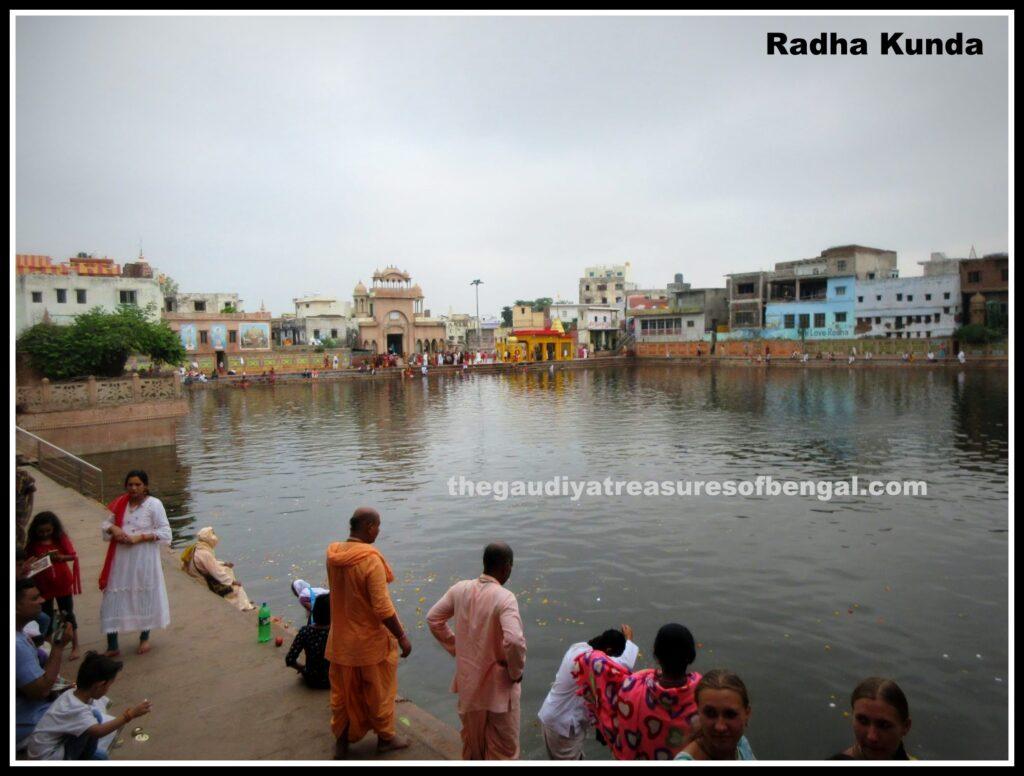
Kusum Sarovar
Kusum Sarovar, the enchanting floral pond, holds profound significance as it is the very site where Radharani graciously revealed herself to the venerable sage Sri Narada Muni. Moreover, it is from the resplendent flowers that grace the surroundings of Kusum Sarovar that Krishna lovingly adorns the tresses of Srimati Radharani. The name “Kusum” signifies the abundance of blossoms, while “Sarovar” represents a serene pond. In the eternal realm of Goloka Vrindavan, Kusum Sarovar flourishes with a captivating array of exquisite flowers, serving as the divine backdrop for the enchanting pastimes of the eternal Divine Couple.
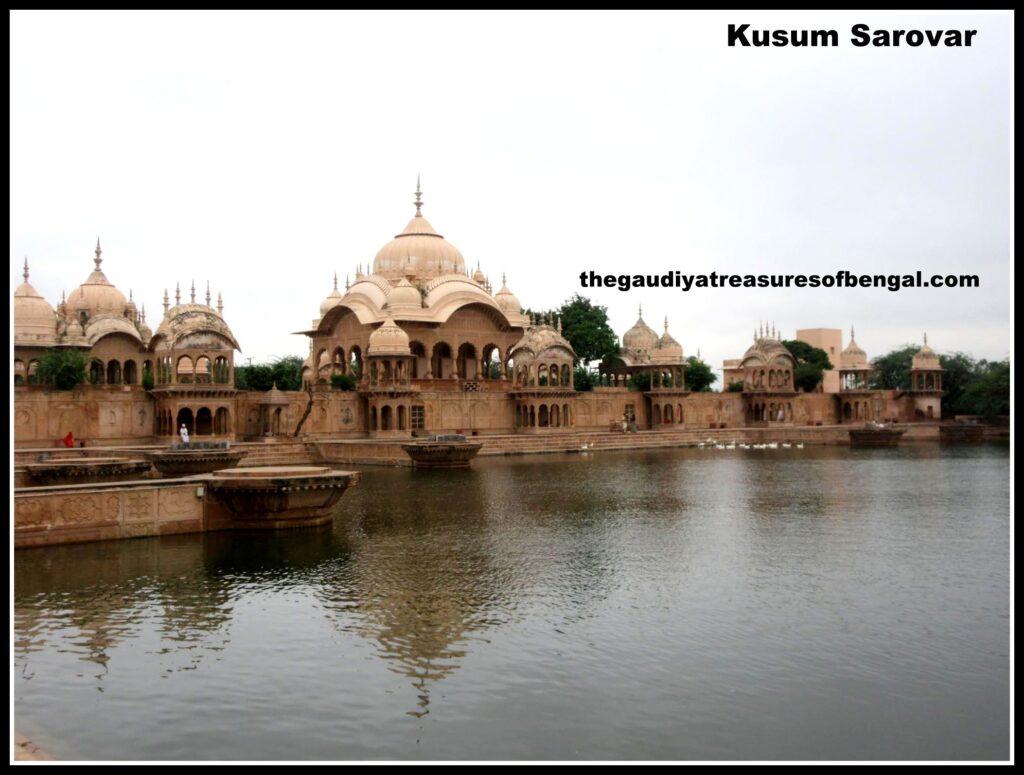
Radha Ban Bihari Temple
Radha Ban Bihari temple, nestled adjacent to the mesmerizing Kusum Sarovar, is the hallowed place where Krishna bestows his tender affection by adorning the flowing tresses of Sri Radha.
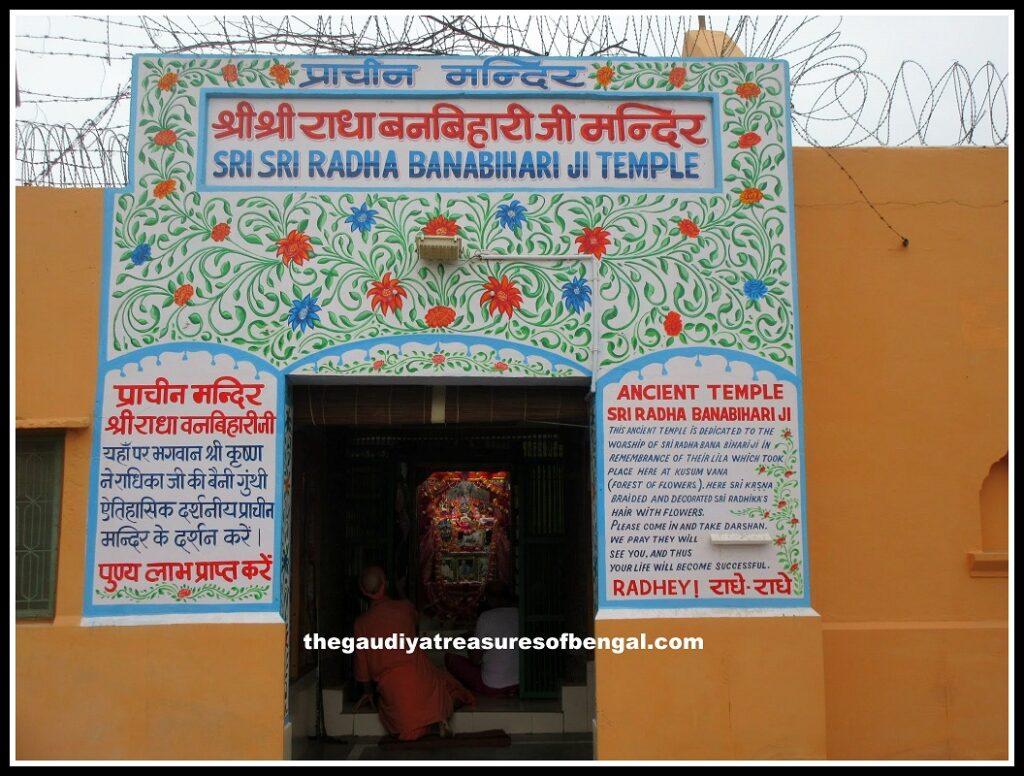
Uddhava Kunda
Uddhava Kunda is located precisely to the west of Kusum sarovar, on the right side of the parikrama path encircling the majestic Govardhan Parvat. It was the revered Vajranabha Maharaja (great grandson of Krishna) who brought forth the existence of Uddhava-kunda, under the wise guidance of Sandilya muni and other revered sages. Uddhavaji, the intimate confidant of Lord Krishna, perpetually resides in close proximity to this sacred spot, assuming the form of grass and shrubs, eagerly awaiting to be blessed by the dust from the lotus feet of the Vraja gopis.
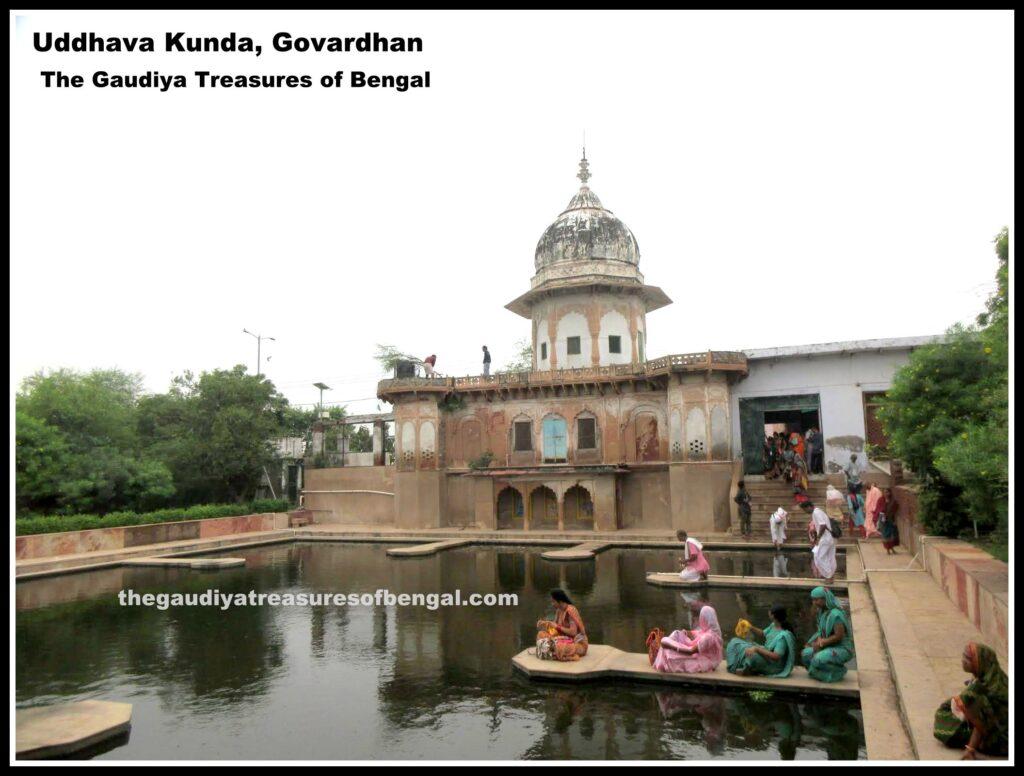
Dan Ghat Mandir
This temple commemorates the Dana Lila (tax collecting pastimes) of Sri Krishna. In a playful guise as a tax collector, Krishna intercepts the enchanting gopis as they embark on their journey to the market, bearing pots filled with precious ‘makhan’, their cherished butter. Requesting his due tax, Krishna is met with a spirited rebuttal from the gopis, who boldly proclaim that Radha, the embodiment of beauty, reigns as the Queen of Vrindavan, questioning the legitimacy of his authority. Unfazed by their defiance, Krishna asserts that he is the tax collector appointed by the Lord of Beauty Himself, emphasizing that their inherent beauty necessitates their contribution.
Amidst playful banter and laughter, the gopis dismiss Krishna’s claims and continue on their path. Yet, little do they know of Krishna’s mischievous intent. Swiftly, he skillfully aims pebbles at the pots gracefully balanced atop the gopis’ heads, causing them to spill their buttery treasures. As the realization dawns upon the gopis, their hearts brimming with both amusement and slight dismay, they hasten to share their misfortune with Mother Yasoda, seeking solace and understanding.
Mansi Ganga
In a heartfelt desire to immerse themselves in the purifying waters of the Ganges without venturing beyond the sacred land of Vraj Bhumi, Yasoda Maiya and Nanda Baba witnessed an extraordinary manifestation of Krishna’s divine grace. With his divine potency, Krishna conjured Mansi Ganga (Ganges created by Krishna’s mind), a crystalline stream that originated from the depths of his very consciousness, flowing gracefully at the enchanting vicinity of Govardhan.

Haridev temple
Haridev Temple, a renowned sacred site, holds a position of significance on the banks of Mansi Ganga lake at Govardhan Hill in Vrindavan, India. It stands as a special place where millions of pilgrims flock each year, seeking blessings for their spiritual journeys. The temple’s construction was commissioned by King Bhagandas of Jaipur. The original deity of Haridev was relocated to the town of Rajdhani near Kanpur when the Mughals launched an attack. However, over time, the whereabouts of the deity became unknown, leaving it shrouded in mystery.

The history of the Haridev Temple is a tale deeply rooted in devotion. On a particular day, Srimati Radharani and the gopis eagerly awaited Krishna’s arrival. As they anxiously yearned for His presence, the gopis experienced an intense separation, causing them to repeatedly chant “Haridev, Haridev, Haridev!” The depth of their yearning reached a point where they were ready to sacrifice their very lives. In that poignant moment, Krishna manifested Himself in the captivating form of a seven-year-old boy, holding Govardhan Hill in His left hand and a flute in the other. The ecstasy experienced by Radharani and the gopis knew no bounds. From that day forward, Radharani and the gopis would visit this sacred place daily, offering worship and adoration to Govardhana-natha Haridev, their beloved deity. The Haridev Temple, steeped in ancient history and resonating with the devotion of Radharani and the gopis, continues to draw countless devotees who seek solace, divine connection, and the blessings of Govardhana-natha Haridev on their spiritual journeys.
Chakleshwar Mahadev temple
Chakleshwar Mahadev, revered as one of the dig-pals or the guardian deities of Braj, holds a special place as the divine protector of the sacred Govardhan Dham. According to legends, this ancient temple was established by King Vajranabh, the illustrious great-grandson of Sri Krishna himself. Lord Shiva, in the form of Chakleshwar Mahadev, assumes the role of safeguarding the sanctity of the holy Govardhan region. Serenely nestled near the enchanting Manasi Ganga, the temple stands as a testament to the deep spiritual significance and divine presence that permeates the area. In close proximity to this temple, one can find the bhajan Kutir (devotional hermitage) of Sanatan Goswami.
Govinda Kunda
Madvendra Puri, the revered spiritual master of Ishwar Puri who in turn was the spiritual master of Chaitanya Mahaprabhu, immersed himself in deep devotional practices at the sacred land of Govardhan. It was during his time at Govardhan that he discovered the enchanting deity of Shrinathji at Govind Kund. These sacred deities, now revered and worshiped in Nathdwara, Rajasthan, hold great significance in the hearts of devotees. The discovery of the Shrinath Ji by Madvendra Puri further adds to the spiritual aura surrounding Govardhan and its deep connection to the worship of Lord Krishna.
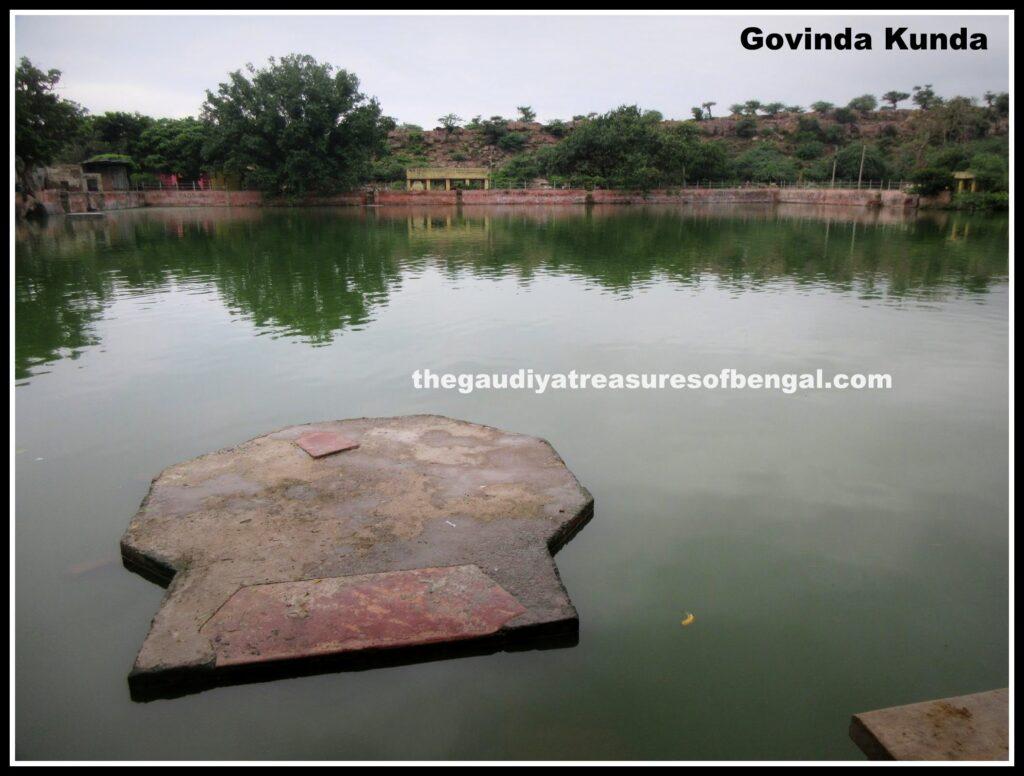
Surabhi Kunda
Surabhi Kunda, a sacred site of immense significance, became the backdrop for a pivotal event in the divine pastimes of Krishna. It was at this very place that Indra, the king of the demigods, humbly approached Krishna to seek forgiveness for his misguided actions. In a moment of realization, Indra understood the gravity of his mistake in attempting to unleash destruction upon the enchanting realm of Vrindavan.
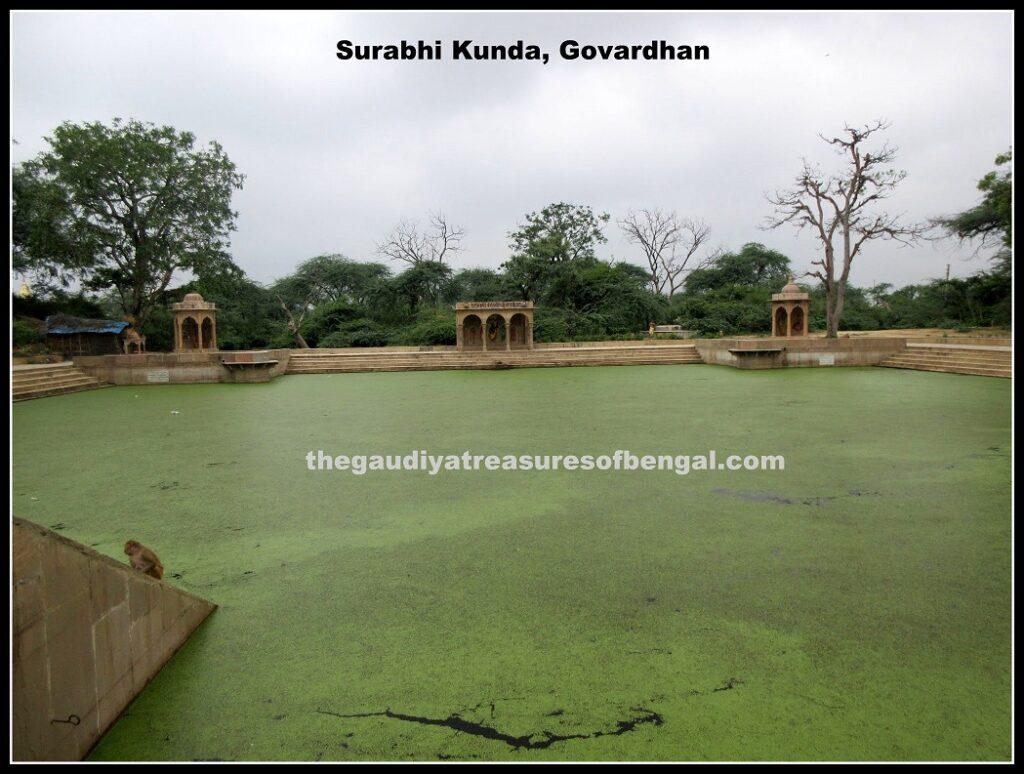
With utmost remorse and a heart filled with reverence, Indra, accompanied by the celestial beings, offered their penitence by bathing Krishna in the pure and nourishing milk from the beloved Surabhi Cows, the divine bovines. In this profound act of surrender and atonement, Krishna, adorned with the milk of the Surabhi Cows, was bestowed with the name Govinda. This divine appellation signifies His role as the protector of the cows (gau) and the gopis, the cherished companions of Krishna.
Jatipura Mukharvind
Mukharvind Temple, situated at the base of the sacred Govardhan Parvat, holds a significant position as the center and iconic symbol of this holy mountain. Located in the quaint village of Jatipura, it rests 25 kilometers from Mathura, and 30 kilometers from Vrindavan. Renowned by various names such as Jatipura Temple or Giriraj ji Temple, it derives its popularity from being the lotus face of Govardhan and the beautiful countenance of Lord Krishna. Legend has it that Mukharvind Temple, also known as Giriraj ji Temple, played a pivotal role in one of Lord Krishna’s divine acts. It is believed that during a tumultuous downpour, Krishna saved the inhabitants of Vrindavan by enacting the captivating Govardhan Lila, where the young Krishna lifted the massive Govardhan Parvat. This is the sacred site where the Govardhan lila manifested and serves as a testament to that awe-inspiring event. For followers of the Vaishnava sect, the Mukharvind Temple holds immense reverence and is considered a highly sacred place. Devotees from all corners of the world visit this temple throughout the year, drawn by its spiritual significance and divine aura. The temple stands as an essential destination for those undertaking the Govardhan Parikrama, a pilgrimage that encompasses the circumambulation of Govardhan Parvat.
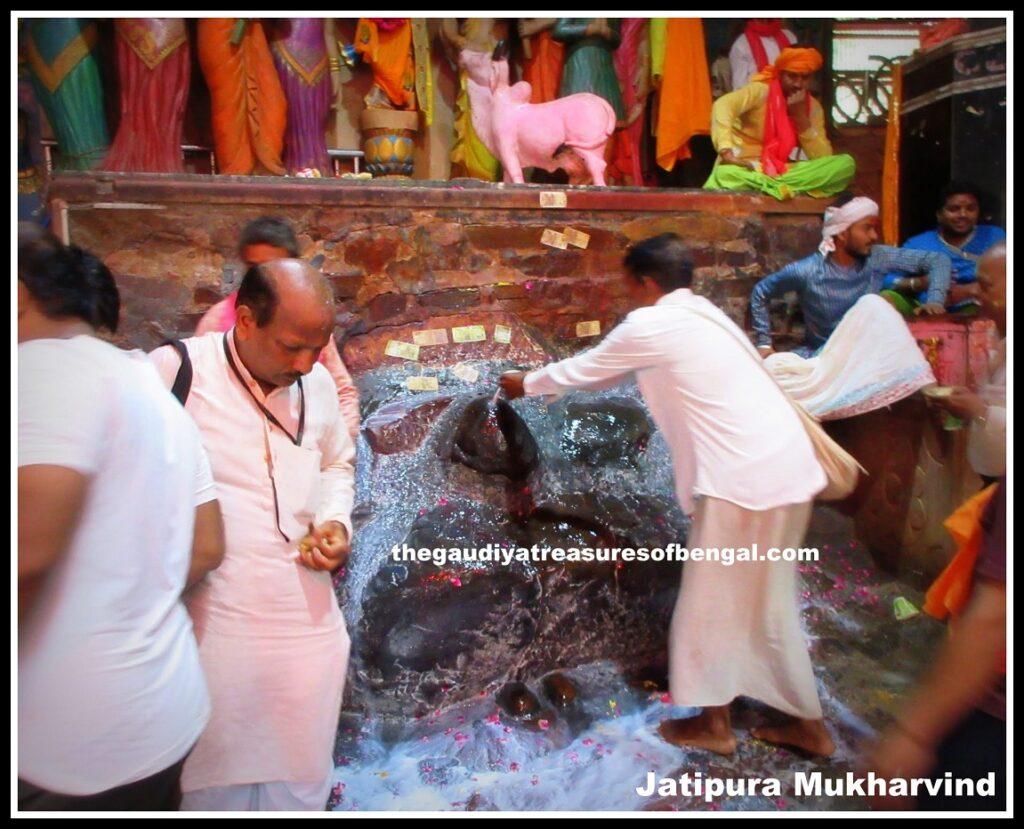
Puchri ka Lota
Puchri ka Lota, is the tail of Govardhan, takes on the enchanting form of a peacock when viewed from above.
Srinath ji Temple, Puchri
Shrinathji, the captivating deity of Lord Krishna, was originally installed by King Vajranabh, who was Krishna’s great-grandson, around 5000 years ago. This deity of Krishna was later discovered by Madhavendra Puri in the sacred land of Govardhan. The deity appeared to Madhavendra Puri in a dream, revealing the exact location where it was concealed. With the divine guidance received, the deity was excavated and worshiped at Govardhan with utmost reverence. Eventually, the revered deity was relocated to Nathdwara, a town in Rajasthan, where it continues to be venerated to this day. The shifting of the deity to Nathdwara marked a significant chapter in its history, as it became the focal point of devotion for countless devotees in that region.
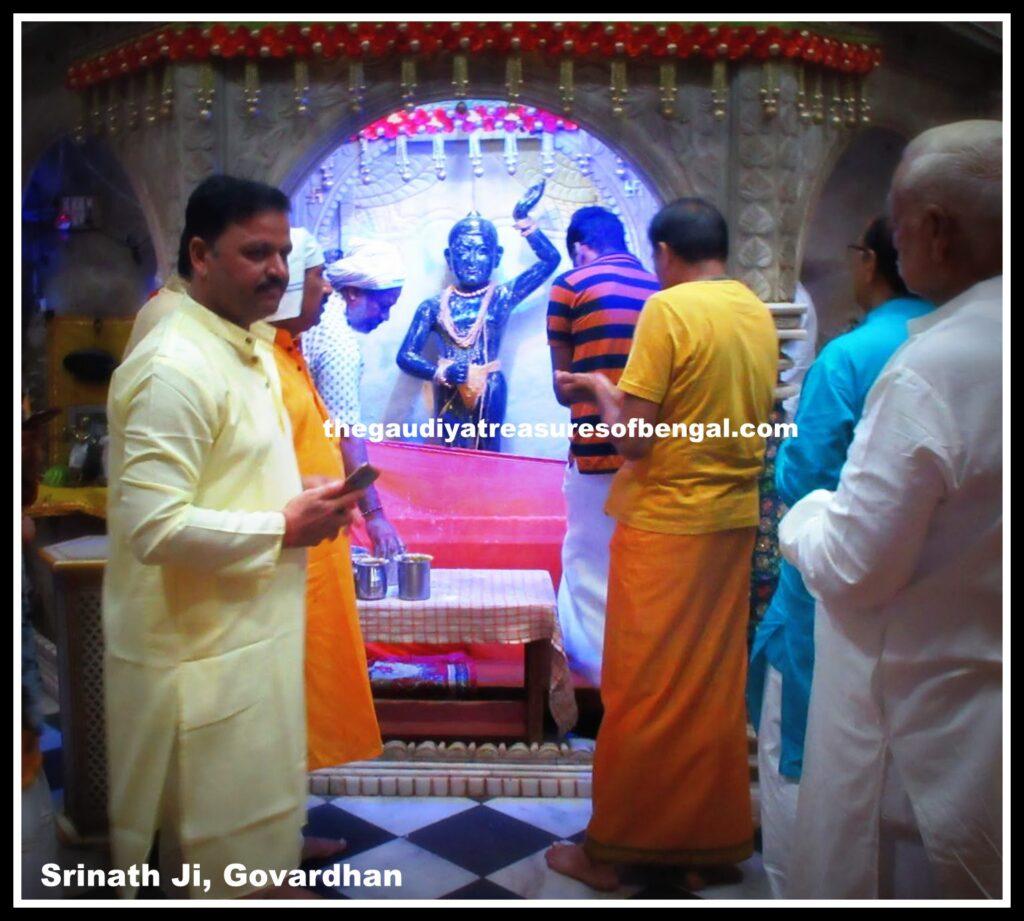
In the present time, at the holy site of Puchri, a remarkable “Pratibhu murti” or replica of Srinathji is worshiped. This replica serves as a means for devotees to express their devotion and reverence towards the divine presence of Shrinathji, even though the original deity resides in Nathdwara. The enchanting journey of Shrinathji, from its installation by King Vajranabh to its discovery by Madhavendra Puri, and its eventual establishment in Nathdwara, is a testament to the deep spiritual connection and unwavering devotion that spans centuries.